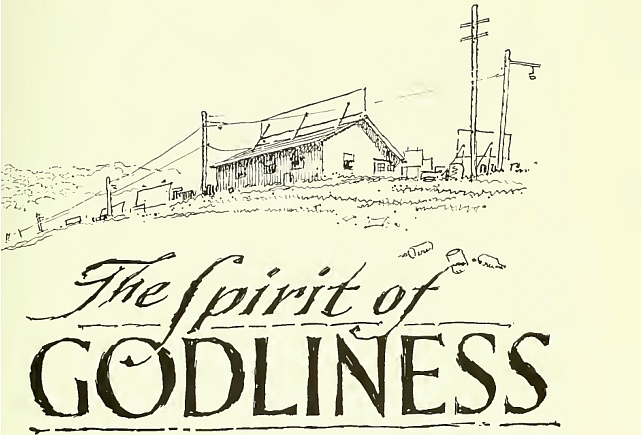In my youth, we sang a hymn that went: “You ask me how I know he lives; he lives within my heart.”
Honestly, I’m not sure that this line made much sense to me as a kid, at least not to an aspirational rationalist. As years have gone by, I have a better understanding. It’s a distinctly American idea.
It seems to be pointing to the truth that faith is ultimately a personal matter, the most personal matter. It is something we accept or reject as a matter of the life of the individual mind and heart. That is how we know.
Regardless of the belief structure, faith tradition, or denominational affiliation, the American experience has required that every religion draw its adherents based on personal choice. You can accept or reject.
Maybe that doesn’t sound radical today, but there was a time when such a system was outlandish and seemingly unworkable. Around the time that the colonists arrived at Plymouth, the religious wars were still raging in Europe, as fallout from the Reformation. The perception was that every country had to choose: Protestant or Catholic. You could not have freedom of choice.
Why was this? Because church and state had been long tied together. The church signed off on the political leadership, and the political leadership gave protection to the church. They had made a deal that lasted a millennium. When the Reformation took place, chaos broke out. People fought it out.
In time, of course, and about the same period that American colonial life was emerging as a rich and good experience, the religious wars gradually came to an end. They were expensive in lives and property. The notion of liberty in the modern sense was born and germinated over time.
As it turns out, everyone is better off simply deciding for themselves and their families what faith to follow. All this system asks is that we tolerate the decisions of others as they tolerate ours. There is peace at last.
The colonies at first attempted official religions with a European-style mix of church and state, but it never really took hold. People were moving around too much. Many were only in America because they were religious dissidents. They had a history of being put upon. Why would they do that to others? They were grateful enough for the freedom to believe and practice.
Plus, there were better things to do than fight over faith. They had houses to build, towns to found, civic matters to tend to, and the crops and livestock always needed attention.
The Americans were simply too busy to bother with religious wars. By the time of the founding, it seemed pretty obvious what the new system should be. There should be absolute freedom of religion. It was put in the First Amendment to the U.S. Constitution.
“Congress shall make no law respecting an establishment of religion, or prohibiting the free exercise thereof.”
Amazing words! The whole of recorded history was a story about people killing and dying and pillaging over religious struggles. The Americans had this crazy idea: let people believe what they want to believe just so long as they let others do the same.
This did not harm religious practice. Quite the opposite. Films recreating the Colonial and Founding experience don’t show this, but faith was everywhere present in people’s lives. Religion was the basis of education, civic celebrations, health care and hospitals, care for widows and orphans, and so much more.
Faith was life and life was faith. Both were woven together by this idea called freedom.
It began to catch on around the world, while the Americans began to embrace it even more. In the 19th century, there were waves of religious revivalism leading to every manner of belief structure and religious leader. America became the home for what might be called religious entrepreneurship. Someone would experience a calling and set up a religion and recruit members.
Something like this would have been unthinkable in the old world. In the new, it seemed possible. That is how this country became the home to so many diverse faiths. It’s astonishing to consider how many. Nothing shocks us really. We are temperamentally happy for people to believe whatever they want so long as they do the same for others.
We look back at wars fought between the believers in transubstantiation and consubstantiation, complete with stockades and hangings, and we simply cannot imagine such a thing. Yes, some historic faiths took a while to come around to this idea of religious freedom, but even the Catholic Church came around to the notion by 1963.
For the most part, and despite well-known exceptions in our history, the idea of religious freedom has been an integral part of the American experience. This is what made it so shocking and appalling that in 2020-21, many churches were forcibly closed and religious observance restricted based on claims of public health.
I knew at the time that this would be a bridge too far. Mess with people’s faith and you create a lifetime of fury.
For instance, the mainstream media criticized Jewish weddings and funerals for not following “social distancing” guidelines. However, some things are more important than government officials’ public health measures.
It is unlikely that a situation like this will occur again in our lifetime. Surprisingly, it has sparked a significant resurgence of faith in America. Houses of worship are once again filling up, and belief is on the rise after years of increasing secularism. In essence, those who tried to suppress it inadvertently sparked a wave of religious revivalism—once again!
This is the essence of the American narrative. Our experiment in allowing diverse faiths to flourish has created the most remarkable garden of religious diversity in the world. It serves as a shining example to all. This is yet another gift that America has given to the world. The freedom of conscience owes much to the history of this nation.
Opinions expressed in this article are those of the author and do not necessarily reflect the views of The Epoch Times.








